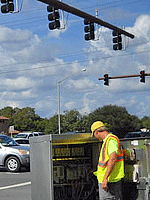 Historic City News readers who live or work at the beach know all too well that the intersection of State Road A1A and State Road 312 get pretty messy at 5 o’clock.
Historic City News readers who live or work at the beach know all too well that the intersection of State Road A1A and State Road 312 get pretty messy at 5 o’clock.
On one side, tourists returning from St. Augustine’s beaches try to navigate their way to hotels and restaurants. On the other side, commuters try to make their way home to residential neighborhoods.
Cars wait and wait for turn arrows, while some locals cut through fast food parking lots to avoid the red lights.
Waiting at traffic lights not only frustrates drivers, it’s not good for the environment. Idling vehicles use up to several billion gallons of fuel and emit large quantities of air pollution and greenhouse gases each year.
St. Johns County has received recognition from the United States Department of Energy for its efforts to save money, energy and the environment by tackling the traffic light timing problem by creating shorter stops.
Through a $276,000 investment from a $438,000 Energy Efficiency and Conservation Block Grant, the county will improve traffic flow by re-synchronizing signals at five major road segments. In total, 23 traffic signals will be retimed and synchronized, resulting in lower fuel consumption, shorter travel times, increased travel speed, less stopping and less engine idling.
The county estimates drivers will save nearly 729,000 gallons of gasoline and reduce CO2 emissions by more than 2,200 metric tons annually.
“This grant is a great example of interdepartmental cooperation within our County staff,” County Administrator Michael D. Wanchick told Historic City News.
“Jay Kamys of the Environmental Section identified the grant opportunity,” said Wanchick. “Then, the Engineering Division staff, led by Assistant County Engineer Andy Ames and Traffic Manager Greg Kennedy, performed extensive research for the grant and prepared the application.”
Kamys submitted the grant on behalf of the County and serves as the County’s point of contact. Traffic Signal Technicians Hank Mein, Jerry Andrews, and Jay Jarrard will perform the field work that implements the improved signal timings, according to Wanchick.
“These are major arterials in the county,” says Kamys. “The changes at these intersections will affect traffic flow. We’re looking to get the most “bang-for-our buck” effecting these changes with a well thought out and targeted plan.”
The county is hiring a consultant who specializes in traffic light synchronization to provide the engineering reports for the project. The program is scheduled to be completed by April 2012.
“We can’t just say we’re going to change the signals in one day,” says Kamys. “It’s far more complicated than most people think.”
There is a substantial amount of preparation that needs to be done before the actual changing process can begin, including traffic counts at major intersections—how many cars go through and how long do they wait—and figuring out timing between sets of lights.
On top of that, there are other things to consider, like left-turn-only lanes and no-right-on-reds.
“Turning movements can be different depending on the day of the week and time of day,” says Kamys. “There are a lot of factors to consider with these lights.”
Photo credits: © 2010 Historic City News photograph contributed by St. Johns County Engineering Division
Discover more from HISTORIC CITY NEWS
Subscribe to get the latest posts sent to your email.
